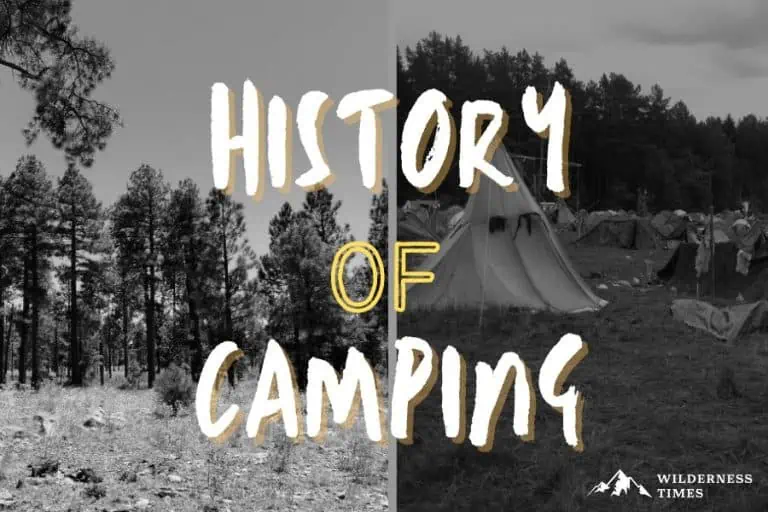For millions of people, camping is one of the most enjoyable outdoor recreational activities. But for the most part of the history of camping, it wasn’t done for leisurely purposes.
So, where and when did camping start? And how has it changed from functional to recreational?
Today, we’ll take a look at the history of camping, beginning with ancient civilizations and ending with camping as we know it today.
Ancient Civilizations & Camping
Setting up a camp is no novelty – people have been doing it since ancient times.
But while we enjoy camping as a way to pass time in the outdoors away from our busy lives, “camping” was most often a necessary form of shelter for different peoples and for different functions.
Early Indigenous Cultures (3000 BCE-1000 CE)
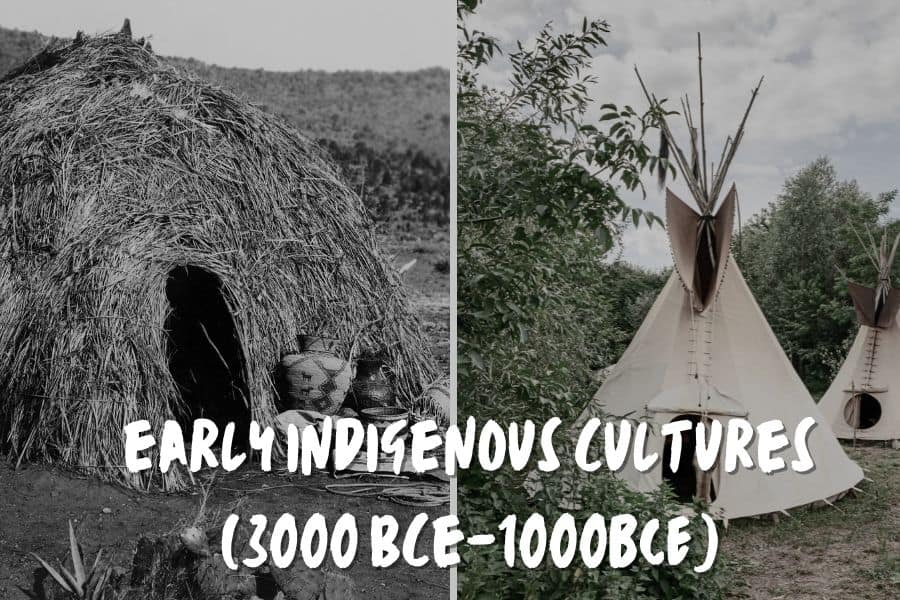
As with most things in history, we can trace camping all the way back to the beginning of people and civilizations, especially through Indigenous cultures.
For the sake of this article, we will focus primarily on North American native people and their connections to the history of camping.
However, most native tribes have fascinating oral histories that are always worth the research if you wish to know more!
Before the establishment of civilization, most groups of people lived hunter-gatherer lifestyles.
They were fairly nomadic because they moved where the food sources were depending on the season.
Historians haven’t found many fossils or documentation of their housing situations that far in the past.
However, they assume that native tents were used to provide protection from weather while still being easy to put up and take down.
They were probably made from materials like animal skins and wood.
But the start of the Woodland period marked a shift in the way these early groups lived/camped.
This was due to the creation of early civilization. After that, Native Americans gave up on nomadic life and built more permanent settlements for agriculture.
The most common types of shelters inside these settlements were wigwams and longhouses.
While the former was designed to fit a family, the latter could house a whole tribe.
These buildings had frames of arched wooden poles that were covered with some kind of bark roofing material.
That could have been anything people found at the time: grass, reeds, bark, mats, hides, cloth.
They still enjoyed seasonal goods, like fish and nuts. So, small groups would often travel to hunt or trade with other tribes.
These travelers obviously opted for less permanent and more portable shelters: tipis.
This cone-shaped tent is one we recognize easily.
Its shape is usually made by wrapping sewn animal hides around a structure of poles that poke out at the top to form a smoke hole.
Bedouin People (6000 BCE-present)
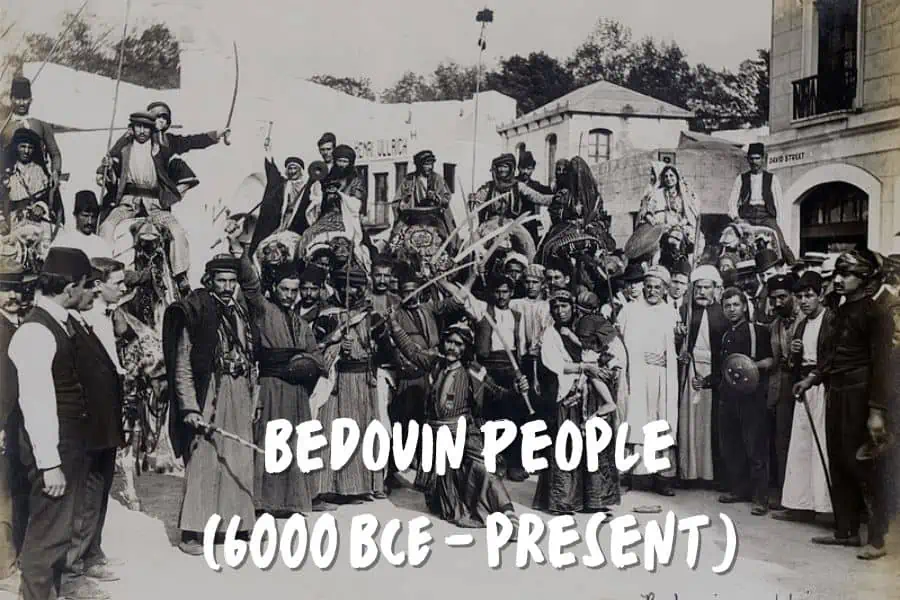
Some of the earliest campsites can be traced back to the Bedouins. This nomadic tribe inhabits desert regions in the East from the Arabian Peninsula to Maghreb (North Africa).
From spring to fall, Bedouins have traditionally migrated in search of pastures for their livestock to graze.
As long as there was enough grass in the area, they would set up a camp and settle down – always near a water source.
Bedouins lived in black, goat-hair tents named Bait Al Shaar.
These tents were not just a shelter from the harsh desert weather, but they were also a place for entertaining guests and fellow travelers.
Bedouin women were in charge of the tent-making, an intricate and time-consuming role they still have today.
The whole process from making thread out of goat hair to weaving it into the fabric to sewing the fabric sheets into a tent could take as long as a year.
But the final results are well worth it! During hot summer days, goat-hair tents are about 10 degrees cooler than outside.
And since goat hair is naturally oily, it repels water and keeps the interior dry.
During colder winter months, on the other hand, Bedouins preferred living in more permanent, stone houses back then.
Ancient Greeks (700-480 BCE)
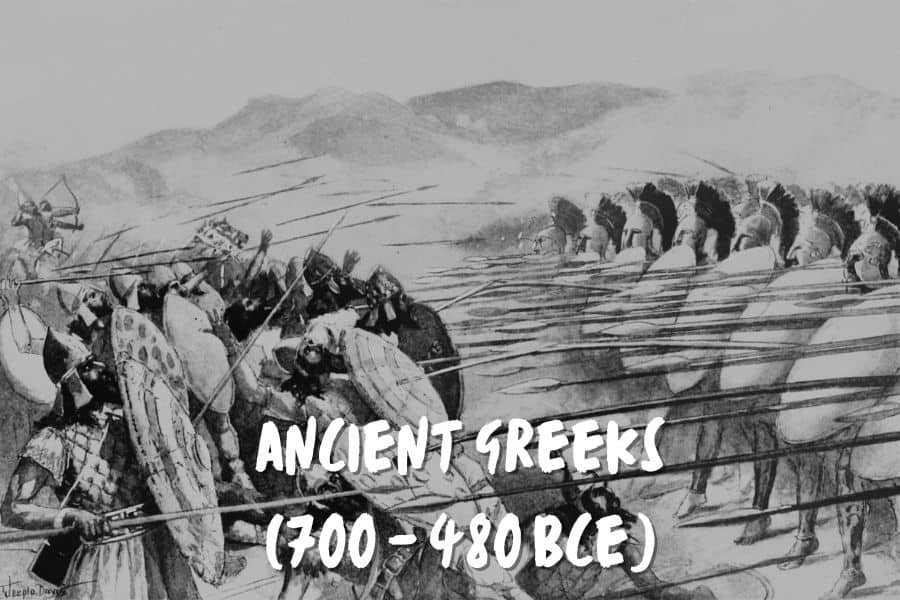
When it comes to ancient Greek military camps, our resources are scarce.
And the reason behind that is the lack of agreement among translators regarding camp terminology.
There are different translations of these terms, which causes a lot of misunderstandings of the written records.
What we do know is that Ancient Greeks used hemp for making tent canvas. In fact, the word canvas comes from κάνναβις, which is Greek for hemp.
Ancient Greeks used this material for practically anything, from boat sails and ropes to clothes and tent fabrics.
Their tents were rectangular, pavilion-styled, and large enough to hold meetings and banquets. Well, at least that was the case with commanders.
When it came to common soldiers, their shelters aren’t mentioned in texts on Greek warfare, but it’s highly possible they didn’t use tents at all.
You see, fighting in ancient Greece was usually done during the summer, when the weather is good enough to sleep in the open air. Ideal conditions, right?
Well, did you know that the Greeks established the Western tradition of laws of war? One of those unwritten norms was that warfare should be limited to summer.
That way, non-professional farmer forces could fight and return home back in time for the harvest.
So, in the warm, Mediterranean climate, soldiers just skipped the tents overall and simply used wool blankets to cover their bodies.
Ancient Romans (753 BCE-476 CE)
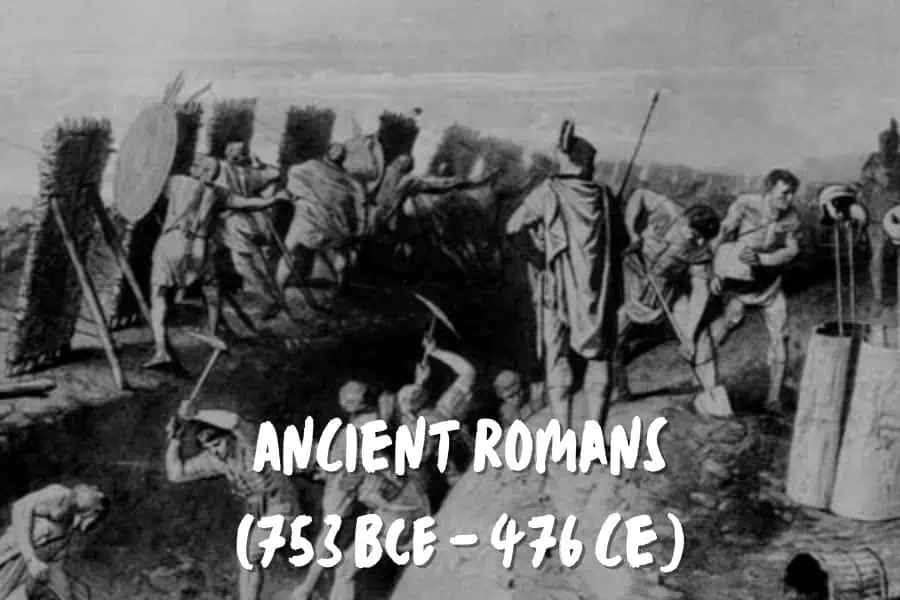
In ancient Rome, temporary shelters and tents were mainly set up for military purposes.
Now, Romans actually had four types of military camps. The most temporary one is castra aestiva (“marching camp”), which was the temporary encampment they would set up at the end of each day’s march.
But aside from serving as a shelter for the night, these marching camps worked as a military strategy as well.
Offensively, they were a staging area for military advance. Defensively, they acted as a safe base for retreating and recovering.
For marching camps, Romans used large goatskin tents with wooden frames, which weren’t very lightweight.
Eight legionnaires would share one box-frame tent, which provided enough room to move around and store gear.
Higher-ranking soldiers’ tents were wider and taller, and they used them for holding meetings.
Regular foot soldiers, on the other hand, slept in bivouac tents that could only fit one person.
Aside from marching camps, Romans had three other types of military encampments:
- Castra navalia – navy camps
- Castra hiberna – winter camps
- Castra stativa – standing camps
These camps were more permanent, with wooden or stone structures instead of tents. Eventually, they turned into settlements.
It’s highly believed that the word “camping” came from military “encampments”, and those camps were pretty similar to what we know today as campgrounds.
The way we currently structure campgrounds is actually very similar to how the Romans did it, so they safely secured their camping legacy.
Medieval Camping (476 -1450 CE)
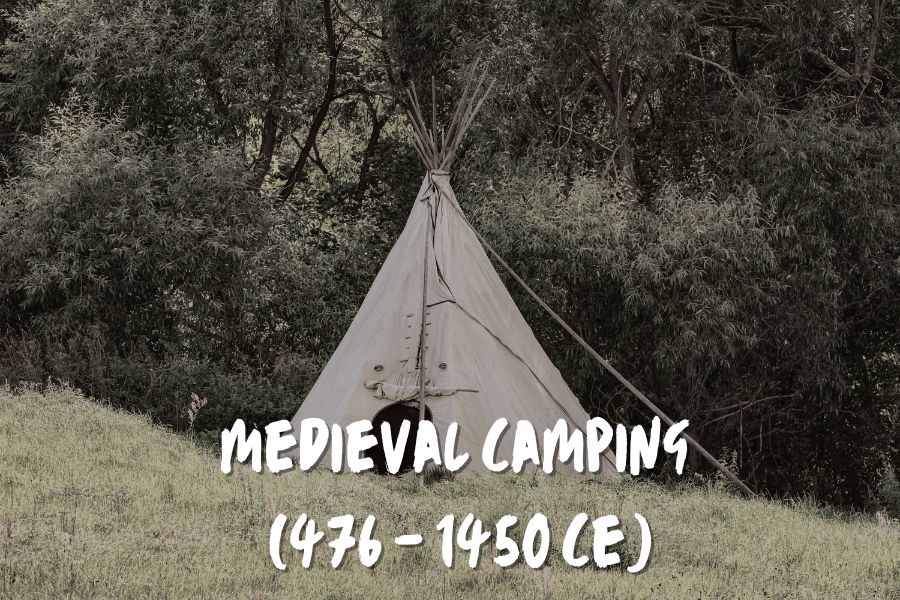
The many territorial expansions and invasions are what define the 1,000 years of the Medieval Period.
Thanks to many manuscripts and paintings from this era, we know a lot about what military temporary bases looked like during this time.
Probably the most popular type of medieval tent was a pavilion. Imagine an umbrella supported by a center pole and held taut with guy lines.
These large tents were often decorated with embroidery, banners, and flags to represent the kingdom the army was fighting for.
Not just for armed expeditions, pavilion tents were also an essential part of medieval events or tournaments.
These tents were where participants were housed and where they prepared for their upcoming show.
Other popular tent types during the Middle Ages were:
- Wedge tents – Self-erected tents consisting of a piece of canvas and three poles, with no need for guy ropes. These tents were often used by merchants and soldiers.
- Bell tents – Conically shaped, these tents only needed a single pole to stand upright. Quick and easy to pitch alone, these tents were often used by solo travelers.
- Geteld trader tents – One side of these tents extended into an awning, offering protection from weather elements. These tents were historically used by Saxons and Normans, but they were also a perfect shelter for a trader.
The Vikings (793-1066 CE)
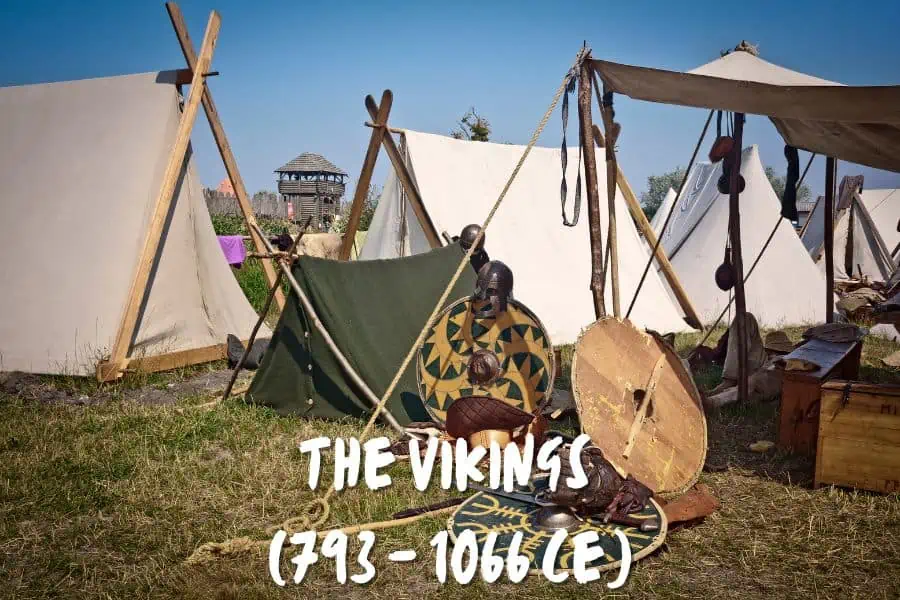
The Vikings were pretty innovative. Aside from setting up camps close to the coast, they would use their tents on the boats as well!
Given they would sail for days, even weeks at a time, those tents would provide temporary shelter from the elements, which can be harsh on the sea.
Vikings were among the first people to use A-frame tents, which proved to be quite sturdy and easy to set up.
To this day, a large number of campers still prefer the advantages A-frame tents can offer over the other types.
The difference between the A-frame tents Vikings used and the ones used at other points in the Middle Ages was the actual frame.
Viking tents used planks as poles, which allowed them to connect the poles together into a sturdy frame.
This kind of frame made them freestanding and very sturdy. That’s why Vikings could easily use them on their ships without worrying the winds would blow them away.
Yes, the tents were pretty heavy, but since Vikings were militant people, they would set up camps for no more than a few days at a time, and only to rest and restock.
But given Vikings traveled most distances by boat, they weren’t bothered that much by weight.
And when they did carry the tents on their back, they would split the weight of the tent parts between all the people planning to sleep in one.
The Crusades (1095-1291 CE)
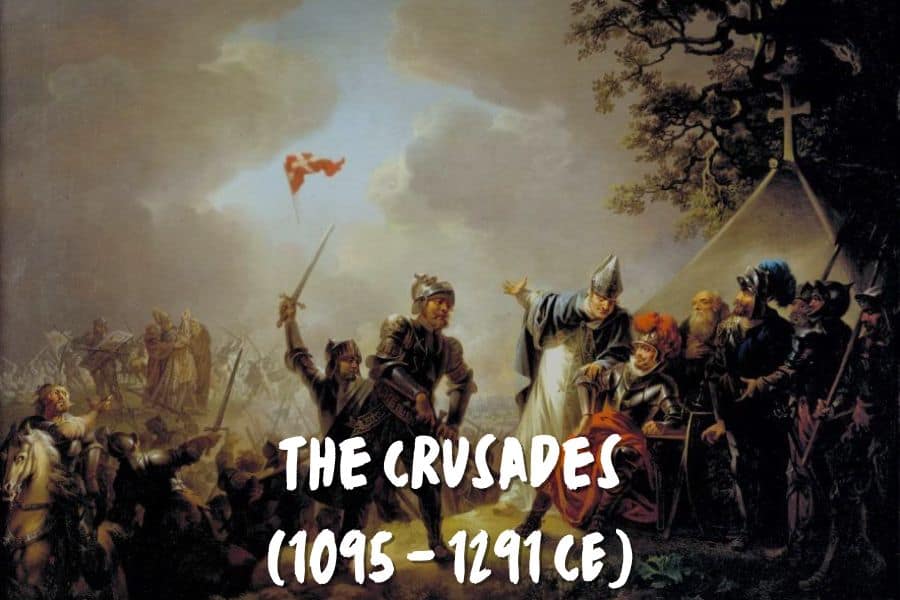
To this day, only a single Crusader encampment has been found, so there’s little material evidence of how they camped.
Most Crusader tents were typically made of canvas. Arguably, the best type of canvas was cotton.
Before cotton was available, the canvas was made of either linen or hemp, both of which had disadvantages.
Linen was expensive and required higher maintenance, but hemp was the heavier of the two.
Aside from means of weather protection, canvas tents were also status symbols during the Crusades.
This European army would use their tents to proclaim their rule and defend their authority.
Because these tents were considered to be “expensive”, they became a way to weaken the perception of their enemy.
Wondering how strong someone’s army is? Just count the tents!
Camping In The Early Modern Period (1450-1800 CE)
The most important characteristic of the Early Modern Period was the increased migration across the globe.
People began traveling further distances, and camping was a necessary part of those travels.
European Exploration & Colonization
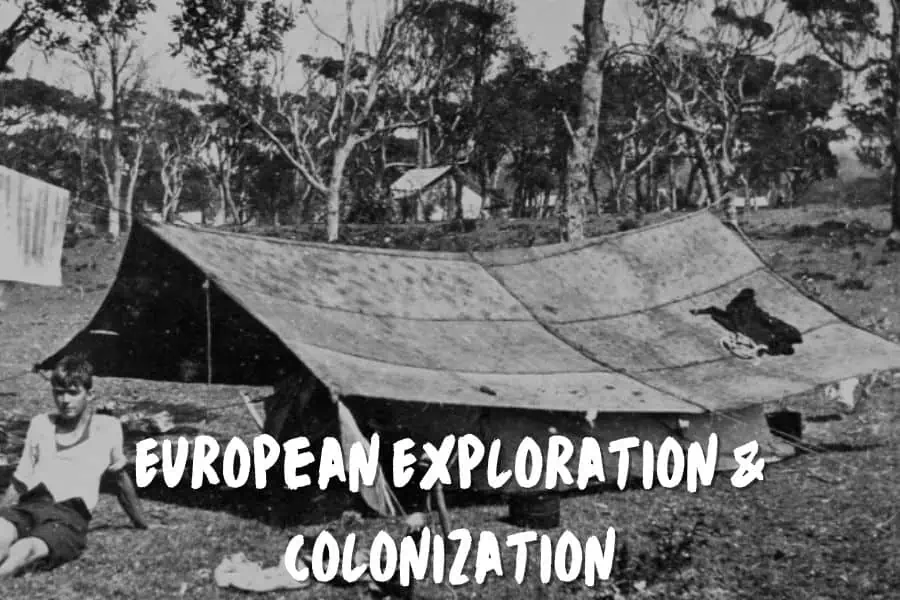
This time in history brought about a lot of exploration and colonization during Western expansion.
Such an adventure usually required a large army and lots of resources needed for such a conquest.
Given the European colonizers were sometimes traveling to other continents, these trips took months, even years to complete.
And since they never knew what to expect when they got there, explorers had to bring everything from weapons and tools to even crops and livestock.
On their routes, they would occasionally set up campsites to rest and recover before continuing on their way.
These were just temporary stops that lasted no more than a few days at a time.
These trips were goal-oriented, and since supplies were limited, they were also time-sensitive.
The Birth Of Recreational Camping
The birth of camping, as we know it today, began around the middle of the 19th century.
The Romantic Movement & Nature Appreciation
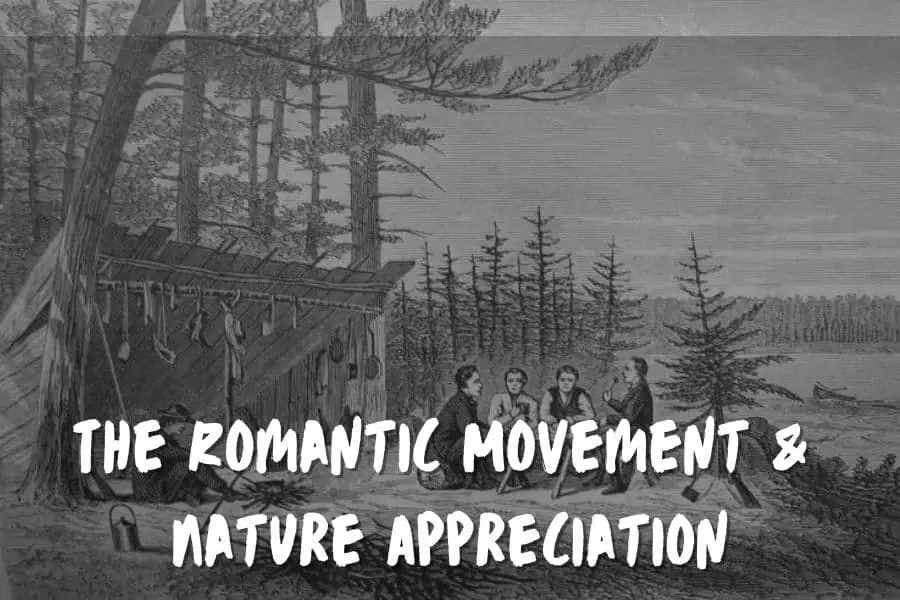
During the Late Victorian Period (second half of the 19th century), pleasure boating on the Thames became a popular pastime.
This leisurely activity often included setting up a social area – and sometimes even a sleeping area – on the banks of the river.
This basically falls under the category of what we consider to be camping – a shelter in nature for the purpose of recreation.
Simultaneously, camping began to gain popularity in the US as well.
In the years after the Civil War, the media promoted a romanticized image of Union soldiers sitting around a campfire.
Basically, these photos were supposed to convince the readers that the war hadn’t been as bad as they might have thought.
While this media campaign may have not affected the public’s opinion on the war, it definitely had an effect on their opinions on camping as a pastime.
The northern post-war economic boom made it easier for people to enjoy camping, but it was William H. H. Murray who changed camping’s outlook.
Published in 1869, Murray’s Adventures in Wilderness started the true camping trend.
The book is a series of short stories about the author’s experiences during his first recreational trip in the Adirondacks.
From guides on what to wear to maps for finding your way around, Murray’s book turned the Adirondacks into one of the most well-known camping spots.
In the years prior to the book’s publication, only about 3,000 people spent time there during the summer. 30 years later, more than 25,000 tourists traveled each summer to visit the famous spot.
The success of Murray’s book can definitely be attributed to the time during which it was published. In the mid-19th century, the Romantic movement was at its peak.
Romantics idealized nature as a source of virtuous ideas and emotions to emphasize that humanity and the natural world were one.
Turning to nature opposed the mechanized, competitive routine of urban areas. And Murray’s book told people how to get away from it.
Thomas Hiram Holding & The Birth Of Modern Camping
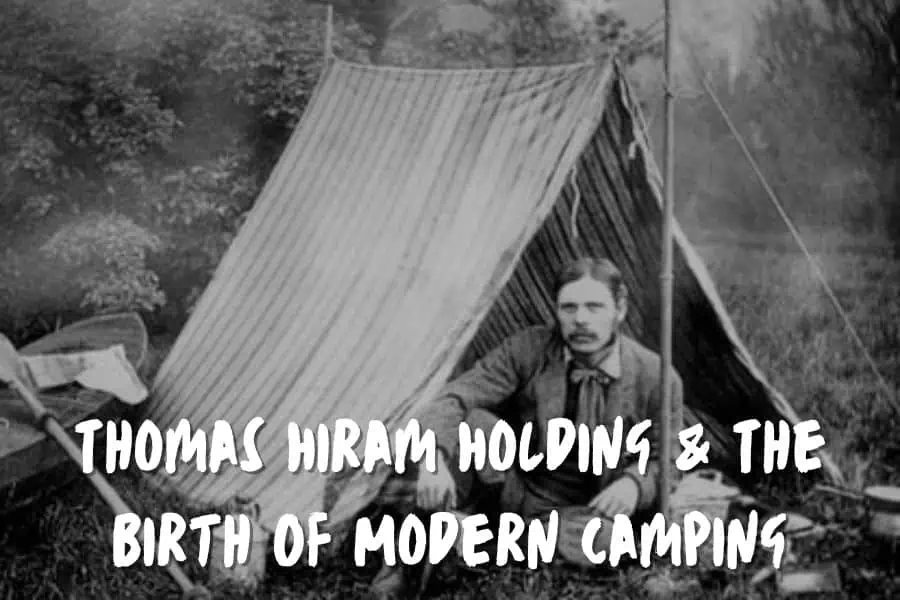
But wait, that wasn’t the birth of modern camping as we know it today just yet.
Because today, we have clubs and organizations that further help improve our outdoor experience. But Murray’s book didn’t spawn those.
The beginning of all that can be traced back to the beginning of the 20th century, and specifically to one man: Thomas Hiram Holding.
Holding was a British tailor, but today, we know him as the Father of Modern Camping. And no, he didn’t win that title for his tailoring skills.
Holding spent his youth traveling across American prairies with his family. Once he grew older, his favorite pastime became cycling across Ireland with friends.
Inspired by his outdoor experiences, he formed the first camping group in 1901, called the Association of Cycle Campers.
Later, they rebranded as the Camping and Caravanning Club.
In 1908, he wrote The Camper’s Handbook, which was a huge hit for outdoor recreation.
It helped in establishing camping as a popular outdoor activity in the UK –and soon across the world.
The Growth Of Recreational Camping In The 20th Century
After Holding’s influence spread, camping evolved at the speed of light into what we consider today to be the essence of this type of trip.
The Development Of National Parks & Protected Areas
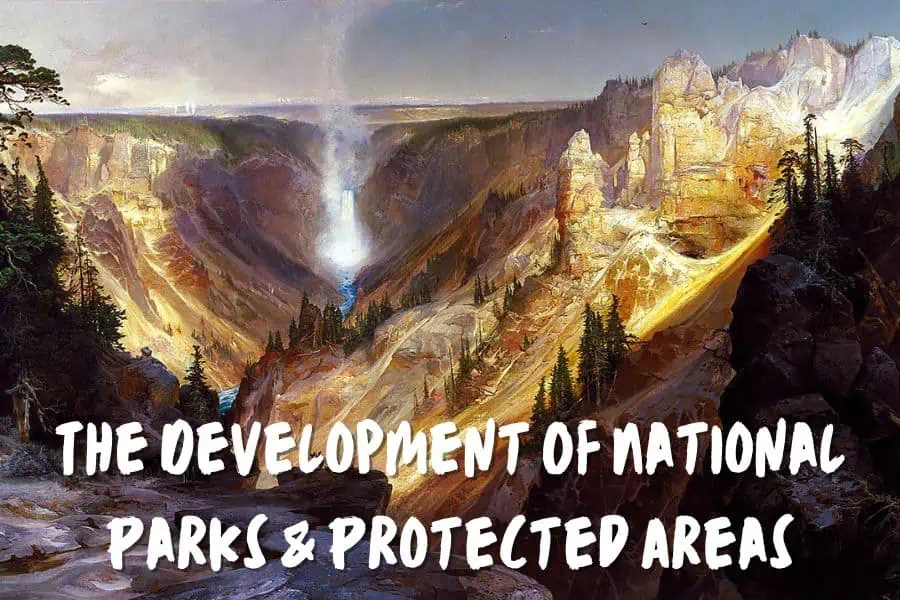
While it wasn’t the first government-protected natural area ever, Yellowstone National Park is considered to be the world’s first national park.
The beauty of Yellowstone caught the eye of Congress.
Then, they decided to prevent the encroachment of settlements from destroying the wonders of the area.
So 151 years ago in 1872, President Ulysses S. Grant signed that Yellowstone would become a national park under the law.
Soon, other areas were also granted this title, like Yosemite and Sequoia National Parks.
Interestingly, railroad companies are the reason for the establishment of national parks across the US.
They promoted the idea that traveling by train would allow customers to enjoy the natural beauty of the States.
So, of course, these companies didn’t want human settlements and industrial areas to interrupt the view of the surroundings.
In fact, they even fought against the use of billboards along the railway tracks as they weren’t aesthetically pleasing to see.
The National Parks Service was then founded in 1916.
Shortly after, President Woodrow Wilson stated their purpose was “to conserve the scenery and the natural and historic objects and wildlife therein and to provide for the enjoyment of the same in such manner and by such means as will leave them unimpaired for the enjoyment of future generations.”
The Popularization Of Car Camping
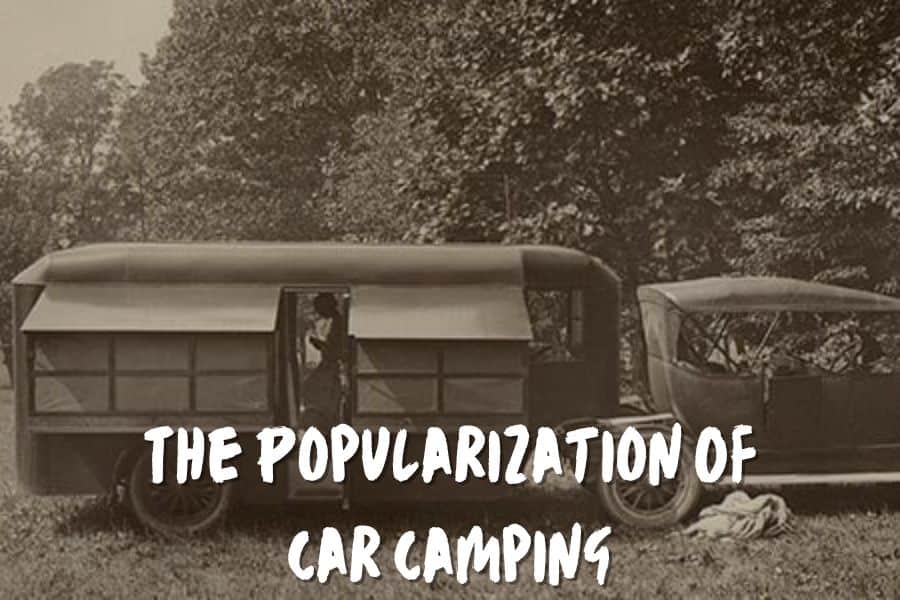
The need for quicker and simpler ways of transportation are the basic reasons for why car camping came to be.
Once more and more Americans owned a vehicle, going camping for a weekend became something readily available to them.
The convenience of motorized mobility quickly gave car companies the idea to create a proper shelter on wheels.
1910 marks the birth year of the first RV, Pierce-Arrow’s Touring Landau.
But the real boom in car camping happened in the 1930s, when cars became more accessible to middle-class Americans.
It wasn’t long after that the first campground was developed.
The Evolution Of Camping Organizations & Clubs
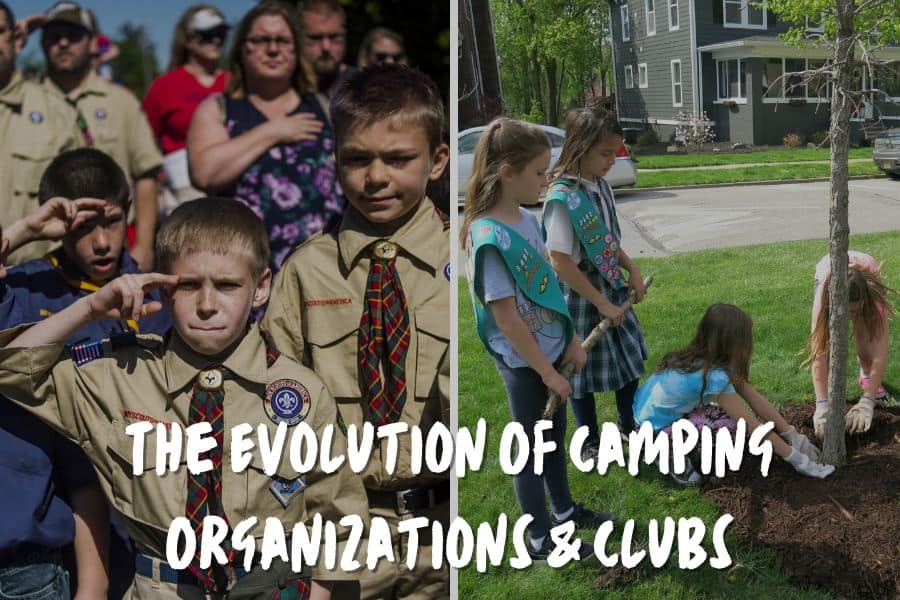
Some of the largest camping clubs and organizations in the US are over a hundred years old!
Boys Scouts were founded in 1910, while Girl Scouts were established two years after that.
Scout clubs are a great place for youth to learn the skills they’ll need to sustain themselves independently in the wilderness.
That includes everything from setting up a camp and cooking to performing first aid and orienteering.
Camping gained worldwide recognition when the International Federation of Camping Clubs (FICC) was founded in 1932.
Soon, national clubs from other countries became affiliated with the federation.
There was then a large network that represented, protected, and promoted camping at the national and international levels.
Today, it numbers 77 federations and clubs from 39 countries, so it can clearly have a big impact on the camping industry.
And really, FICC played a role in things like:
- International classification of campgrounds
- I.S.O. and CEN standardization of equipment, health, and safety
- Stimulation of the camper to protect the environment and cultural heritage
Innovations In Camping Gear & Equipment
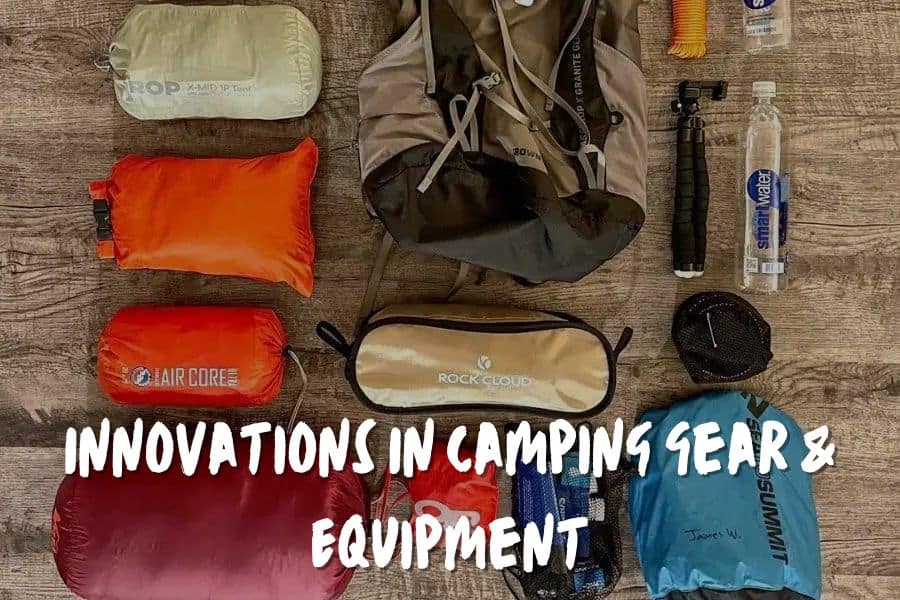
Proper preparation is essential for an enjoyable camping trip. And this was something that was recognized fairly quickly once camping became popularized.
But the actual ancestor of today’s tent was designed before camping became a favorite pastime.
The modern “bell tent” dates back to 1856 and was created by a US soldier who was inspired by a Native American tipi.
But instead of using buffalo hide, he opted for canvas, which is a material that stuck around.
And unlike the medieval bell tent, this one featured an opening at the top that allowed smoke to escape.
While both sleeping bags and compact stoves were designed for the battlefield, their convenience made them suitable for camping as well.
But the real boom in camping gear happened after WWII, when post-war economic expansion allowed the middle class to own “hobby gear”.
In 1957, Coleman introduced the very first insulated cooler designed specifically for camping. Two years after that, Eureka! made the first quick-setup, freestanding tent.
During the early 1960s, lightweight metal poles were invented, which quickly replaced heavy and bulky wooden frames. They were then much easier to carry.
In the 1970s, Eureka! struck again and made the first tent that could fully fit inside a backpack!
The fact that the model sold over a million units within a decade is not surprising, given how revolutionary it was.
The Rise Of Family Camping & Youth Camps
As we already established, both Boy and Girl Scout clubs were formed at the beginning of the 20th century.
This happened during the peak of the American Industrial Revolution, when families were moving from farms to cities, so kids lacked a place to be outdoors.
Now, these organizations weren’t primarily focused on camping, but on youth development in general.
But they did realize that camping and outdoor activities were the perfect place for young members to learn independence and practice making decisions without adult interference.
Of course, enjoying the outdoors wasn’t restricted to just Scouts. Summer camps became popular programs when school was out for the season.
Traditionally, summer camps involved activities like hiking, canoeing, and setting up campfires.
But it wasn’t long before they gained a more academic character, with specialized programs like art, music, or language learning.
And it makes sense really. It’s so much easier to learn and focus on improving skills when you’re surrounded by peacefulness and beauty.
It is no surprise why camping became an activity families can enjoy together.
Both children and adults can rest from work or school and enjoy the fresh air, far away from urban life.
The Influence Of Media & Popular Culture On Camping
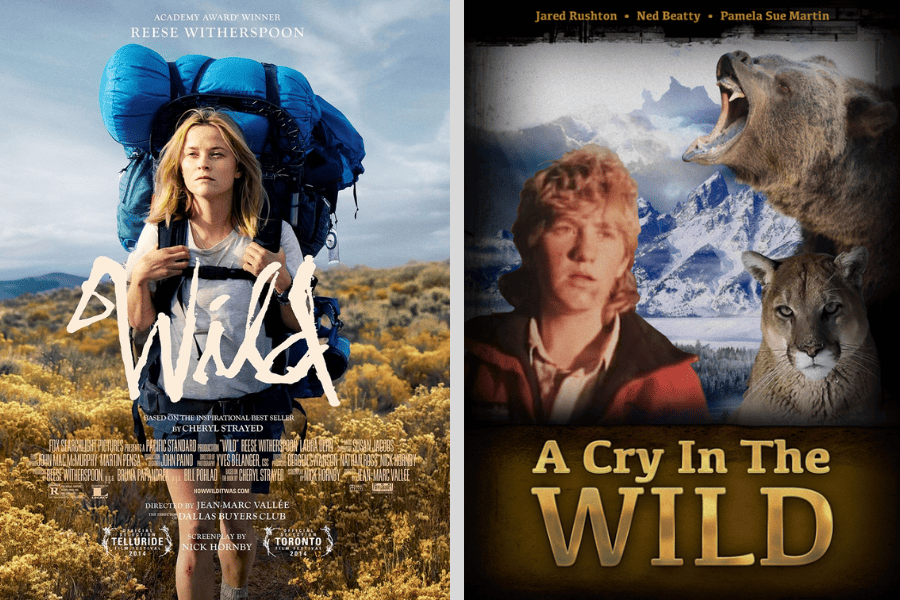
We can’t ignore the effect media and popular culture has had on camping.
Aside from some exceptions like The Revenant (2015) or The Edge (1997), during which the bear fight scenes make you swear you’ll never go into the woods again, most outdoor movies romanticize trips into the wilderness.
For instance, Reese Witherspoon in Wild (2014) surely convinced more people to hike the whole Pacific Crest Trail.
Then, we have A Cry In The Wild (1990), which makes survival in the wilderness seem so simple and self-explanatory, even to a kid.
Now, I’m not saying all of these movies are exaggerating.
Sure, there are certain inconveniences you may have to deal with when outdoors, but it is so rewarding to be surrounded by beautiful scenery.
The fact that camping made its way into pop culture speaks volumes about its popularity.
From movies to documentary films and even reality shows, you could spend months just watching camping or outdoor-related content.
But how do pop culture and media actually affect modern camping, you might ask?
Remember how Murray’s book influenced many people to spend their nature trips in the Adirondacks?
Well, that’s exactly what movies and shows can do: inspire people to travel to those same locations to enjoy the beauty for themselves.
Also Read: History Of Hiking
Conclusion
As you can see from the history of camping, it is no new invention. It’s practically been around forever, even though it was not always the recreational activity we know it to be today.
But ever since the mid-19th century, camping has become a favorite pastime of people who are too tired of city noise and busy life.
Today, camping is readily available for everyone who wants to take part.
From backpacking and primitive camping to glamping and RV camping, you can design your trip based on your needs, wants, and possibilities – whatever they may be!
Next Up: Camping Facts – 75+ Interesting Facts About Camping
Sources:
- Alexander, Kathy. “Woodland Period of America .” Legends of America, March 2025. https://www.legendsofamerica.com/woodland-period/.
- Gadacz, René R. “Tipi.” The Canadian Encyclopedia, September 2017. https://www.thecanadianencyclopedia.ca/en/article/tipi.
- Hays, Jeffrey. “Bedouins Nomadic Life.” Facts and Details, January 2012. https://factsanddetails.com/world/cat52/sub331/item1987.html.
- “House of Hair: A Bedouin’s Tent Is His Home.” UAE – Gulf News, July 2019. https://gulfnews.com/uae/house-of-hair-a-bedouins-tent-is-his-home-1.411756.
- Lanni, Adriaan. “The Laws of War in Ancient Greece.” Law and History Review 26, no. 3 (2008): 469–89.
- Lapina, Elizabeth. “Medieval Tents as Locations of Power in the Context of Crusades.” Institute for Research in the Humanities, December 2019. https://irh.wisc.edu/event/medieval-tents-as-locations-of-power-in-the-context-of-crusades/.
- Martin, Taylor. “The First Production RV Was Built Over 100 Years Ago.” MotorBiscuit, October 2021. https://www.motorbiscuit.com/first-production-rv-100-years-ago/.
- “Quick History of the National Park Service.” National Parks Service. https://www.nps.gov/articles/quick-nps-history.htm.
- Rico, Mauricio. “The Greek Military Camp in the Ten Thousand´s Army.” Gladius 22 (2002). 10.3989/gladius.2002.55.
- Salman, Hind Hajar. “Bedouin Women.” Translated by Hind Husseini. This Week in Palestine, February 2025. https://thisweekinpalestine.com/bedouin-women/.
- Schuster, Ruth. “No Crusader Army Camps Have Ever Been Found. Until Now, in Israel.” Haaretz, October 2021. https://www.haaretz.com/archaeology/2021-10-07/ty-article/a-first-crusader-army-camp-finally-found-in-israel/0000017f-db1f-df62-a9ff-dfdfcee80000.
- Walker, Gary R. D. “Old Norse Tents.” Ravensgard, April 2007. http://www.ravensgard.org/prdunham/tents.html.
- Waxman, Olivia B. “How to Live ‘Amid the Silence of the Woods,’ According to America’s First Camping Guide.” Time, July 2018. https://time.com/5343675/history-of-camping/.
- Young, Terence. “The Minister Who Invented Camping in America.” Smithsonian Magazine, October 2017. https://www.smithsonianmag.com/history/religious-roots-of-americas-love-for-camping-180965280/.


